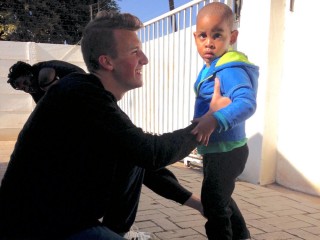Title

Austin Reynolds and several Juilliard classmates worked with children in Gaborone, Botswana, as their Community Engagement Grant project.
This article is one of several about the 2016 Community Engagement Grant recipients.
Body
Place Gaborone, Botswana
Summer Engagement Grant Project Creative Borders—fostering cultural exchange through the language of movement
Participants Fourth-year dancers Austin Reynolds (Juilliard Scholarship), Katie Garcia (Irene Diamond and Edith Rosenhouse-Baehr scholarships), and Sean Howe
Last winter, Katie Garcia, Sean Howe, and I dreamed up the Creative Borders project using the structures of fellowships and service projects we've participated in through Juilliard. In July, thanks in part to a Juilliard Community Engagement Grant, we found ourselves safely touching down on the runway in Gaborone after 29 hours of travel. We spent the next two weeks working with several institutions with different needs for the arts.
Each morning, we led movement classes for children with special needs, such as autism and hearing disabilities, at the Mariri Speech Audiology Therapy School, where we stressed the importance of the mind-body connection. As we said our final goodbyes, a young girl stood in the hallway dancing on the tips of her toes, arms in the air like we had taught her, smiling cheek to cheek. In that moment, we witnessed the purest form of movement as a means of expression. A child who had struggled with language and communication now had a voice—this was an unforgettable gift.
We spent most of our time in Gaborone at the Maru-a-Pula school, which helped make our trip possible by providing us with housing, food, and the local transport necessary for our teaching. Celine Matthee, who heads the school's music department, helped arrange lectures at other local primary schools, evening classes for adults in the community, and most importantly, turned Gaborone into a home for us. At Maru-a-Pula, we worked with several hundred students, teaching ballroom, composition, ballet, and contemporary dance. We also faced the challenge of making the arts matter to both students and parents who stress academic studies as well as some parents who didn't want their sons taking dance classes. But after some encouragement and a few days of trying our workshops, the students who had been apprehensive about asking their parents to participate managed to join in, and by the final days of the workshop, the boys who on day one stood with their arms crossed in the back of the room were dancing jubilantly in the front.
On our last night in Botswana, the Maru-a-Pula students performed what they had learned for the community, and we performed alongside them, sharing our love for the language of movement just as we had imagined back in the beginning of the year for the Creative Borders project. Through moments of incredible joy, laughter, deep learning, and occasional bouts of tears, I realized that our cultures share the same core, and that the people we met in Botswana are incredibly respectful, hardworking, and loving people—and the memories of being with them will never leave us.





